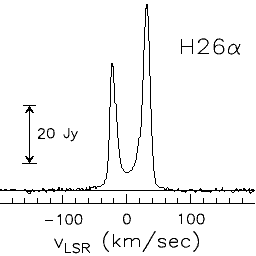![[ Diagram of MWC 349 Disk ]](MWC349.gif) |
Radio Star MWC 349Circumstellar disk surrounding the hot star MWC 349. Maser emissions are thought to occur in outer regions while lasers are operating nearer the central star. (Courtesy Strelnitski et al., 1995) |
![[ Diagram of MWC 349 Disk ]](MWC349.gif) |
Radio Star MWC 349Circumstellar disk surrounding the hot star MWC 349. Maser emissions are thought to occur in outer regions while lasers are operating nearer the central star. (Courtesy Strelnitski et al., 1995) |
The first "natural" laser in space was detected by scientists on board NASA's Kuiper Airborne Observatory (KAO) as they trained the aircraft's infrared telescope on a young, very hot, luminous star in the constellation Cygnus.
Discovery of this naturally occurring laser provides scientists with a powerful tool for probing the conditions in disks of gas and dust surrounding young stars, according to Principal Investigator Vladimir Strelnitski of the Astrophysics Laboratory, National Air and Space Museum (NASM), Washington, DC, who made the discovery. Scientists believe that many of these circumstellar disks are regions where planets are forming.
The laser is created as intense ultraviolet light from the star "pumps" or excites the densely packed hydrogen atoms in the gaseous, dusty disk surrounding the star. Then, when the infrared light shines on the excited hydrogen atoms, it causes the atoms to emit an intense beam of light at exactly the same wavelength, creating the circumstellar laser, according to Sean W. J. Colgan of the Search for Extraterrestrial Intelligence (SETI) Institute, Mountain View, CA, a co-investigator in the discovery.
The discovery was made as the KAO, the world's only flying observatory, returned to Moffett Field, CA, from observing missions based in Hawaii. Co-investigators in the discovery are Howard A. Smith, also of NASM; Michael R. Haas and Edwin F. Erickson, Ames Research Center, Mountain View, CA; and Colgan.
Strelnitski used a sensitive liquid helium-cooled spectrometer attached to the KAO telescope to search for selected "lasing lines" in the infrared region of the spectrum between 50-500 microns (100 to 1000 times the wavelength of visible light).
The natural laser was detected at 169 microns as the scientists viewed the nearly edge-on gas and dust disk surrounding the peculiar star known as MWC 349. The "lasing line" has an intensity six times brighter than non-amplified spontaneous emissions at the same wavelength, Strelnitski said.
The existence of natural lasers was predicted more than 15 years ago, following the successful amplification of both microwave and visible light wavelengths in laboratory experiments, and the discovery of amplified microwaves in space.
(COMMENT: This statement is not exactly correct, stellar lasers were predicted more than a quarter of a century ago by the astrophysicist D.H. Menzel in a remarkable paper on Laser Action in Non-LTE Stellar Atmospheres)
American physicist and Nobel laureate Charles Townes first proposed the practical amplification of electromagnetic radiation by stimulated emission in 1951. In 1954, his group at Columbia University created the first laboratory amplifier of microwaves, calling it a MASER (Microwave Amplification by the Stimulated Emission of Radiation.)
In 1960 Theodore Maiman at Hughes Research Laboratories developed a device to amplify visible light, creating the first LASER (Light Amplification by Stimulated Emission of Radiation.)
Not long after the invention of laboratory masers and lasers, the first natural masers were discovered in interstellar and circumstellar gas clouds. Townes, a frequent investigator onboard the KAO, was among the discoverers of the first strong astrophysical water masers.
Astrophysical masers, due to their extremely high intensity and spectral purity, are valuable tools in studies of the birth and death of their associated stars. On Earth, many scientific and industrial applications of masers and lasers have been developed, such as keeping exact time, bar-code reading in supermarkets and performing "bloodless surgery."
Astrophysical masers can be observed from the ground with special instruments, but the major part of the infrared spectrum where potential lasers might be seen is hidden from the ground observer by Earth's absorbing atmosphere.
This long awaited discovery of a natural laser was made on the last scheduled flight of the KAO instrument -- the Ames Cryogenic Grating Spectrometer. The instrument permits sensitive detection of emission from atoms and molecules throughout the mid- and far-infrared spectral domain.
The KAO is scheduled for retirement this fall. NASA plans to begin development of the follow-on airborne observatory SOFIA in 1996, with first flight scheduled for the year 2000.
Don Savage
Headquarters, Washington, DC August 29, 1995
(Phone: 202/358-1547)
Diane Farrar
Ames Research Center, Mountain View, CA
(Phone: 415/604-3934)
RELEASE: 95-148
95-35

|
H-26-alpha microwave laserSpectral line profile of the H-26-alpha maser transition in MWC 349 (Strelnitski et al., 1995) The shape of this microwave laser line (354 GHz) is similar to the H-15-alpha infrared laser line at 169 microns (1775 GHz). These velocity profiles are typical of microwave laser emissions in many other sources and probably indicate high velocity outflows towards and away from the observer. |